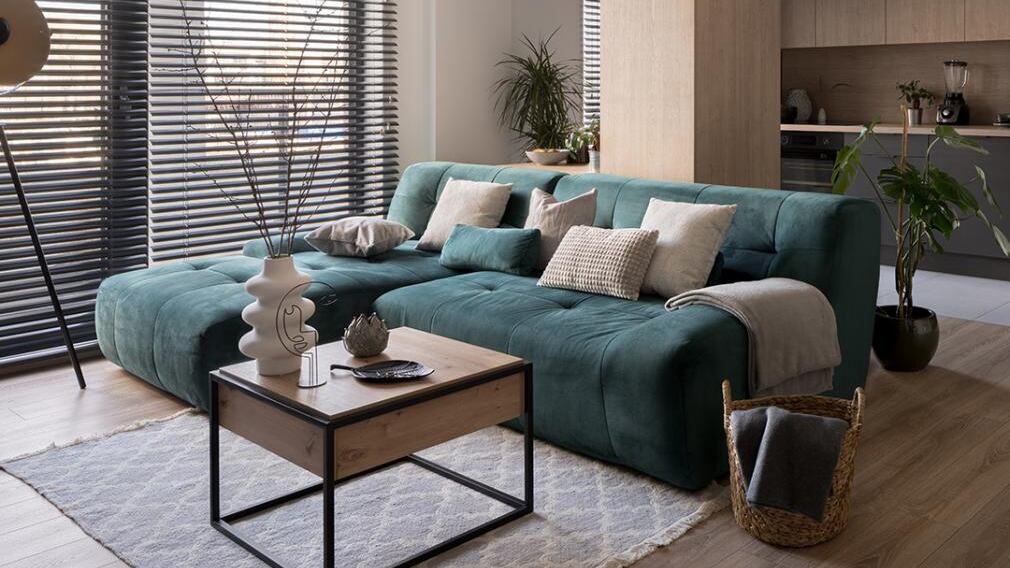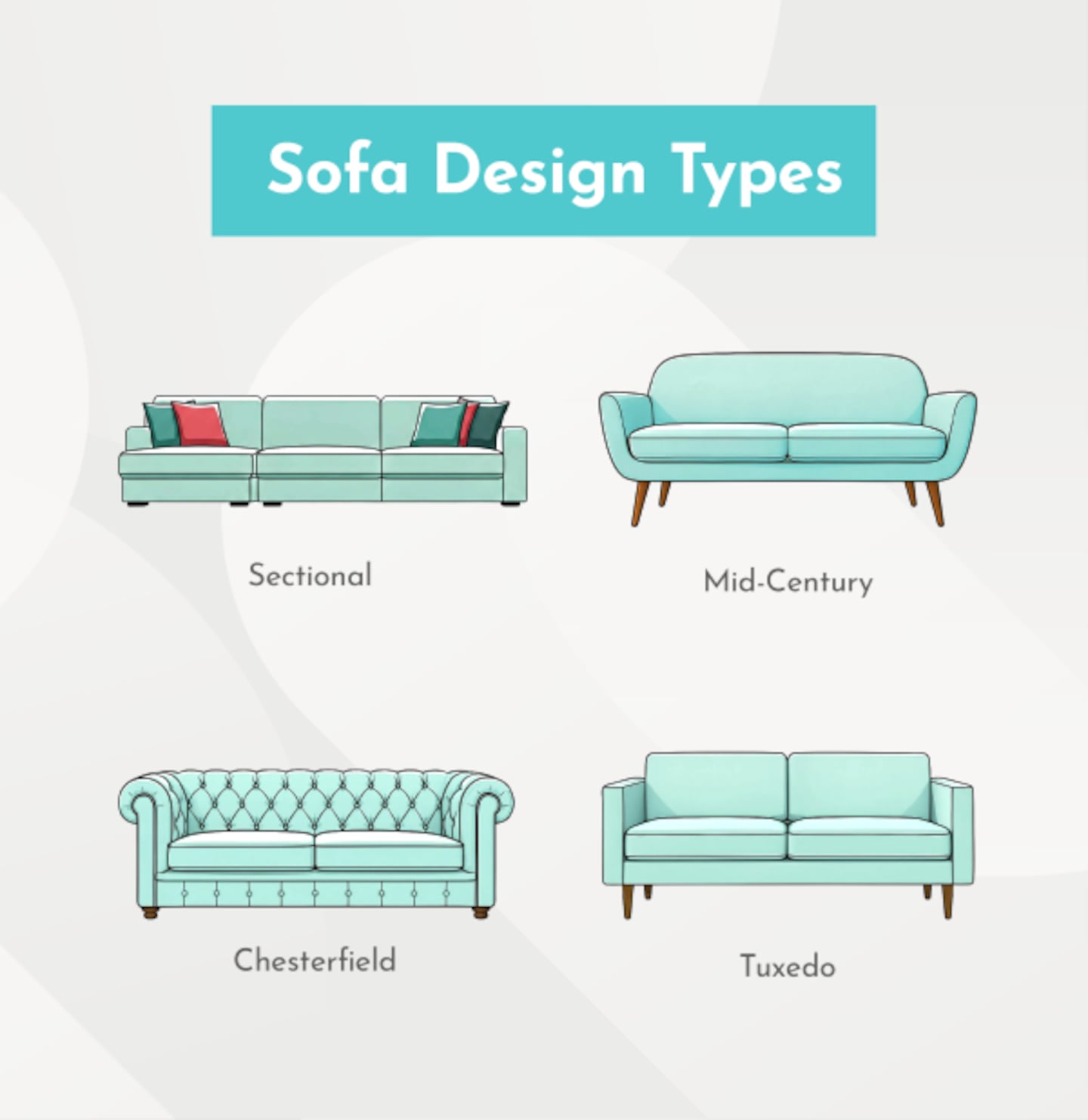In the United States, there's a growing demand for ergonomic sofas and seats. This surge in the need for ergonomic furniture highlights how consumers are prioritizing comfort and support in the designs they choose. One of the most effective ways to enjoy the benefits of ergonomic furniture that supports your needs and preferences is by designing your own custom furniture—including your sofas.
The ability to design your own custom sofa opens up many benefits. Your own custom-designed sofa gives you a meaningful piece of furniture that authentically reflects your personal style. The sofa will also complement your home's aesthetic and layout and provide you with a design that functions well for your space.
Custom sofas are investment pieces. Depending on the design, materials and features you choose, the investment can be one with sentimental heirloom value, monetary value or both.
Designing your own furniture is easier than it may initially seem, and these six tips from DreamSofa for designing your own custom sofa make this home project simple and enjoyable. Bringing your design to life doesn't require exorbitant funds, countless consultations or endless hours of planning. Designing your own sofa is both accessible and rewarding, and custom furniture is a worthwhile investment you'll value for years to come.
Tip 1: Define Your Style
Defining your style is the first step to designing a sofa you love. You may already have an aesthetic you have curated with other pieces of furniture, decor and fixtures. That makes it much easier to design a sofa that fits a specific style. However, it's freeing to remember a custom design is all about having a unique piece. There's beauty in being able to create and express yourself through your design—even if it's different from your usual aesthetic.
With that in mind, some of the most common interior design styles for homes and sofas include:
- Traditional: The traditional style features dark, rich shades, quality wood and natural materials, ornate details, and rich fabrics like silk and velvet. Traditional is a timeless style that often features classic patterns and details like stripes and florals.
- Modern: A modern aesthetic is typically defined by clean, elegant lines, neutral colors, minimalism, and functionality. For a modern sofa design, simple arms, legs and backs work well. Modern sofas will often be in muted shades of brown, beige, cream, white and gray.
- Modern-vintage/transitional: A modern-vintage or transitional style strikes the perfect balance between traditional and modern. With this style, you have the freedom to fit your dream sofa into your existing aesthetic—even if they don't match.
- Bohemian: "Boho" is the perfect style if you want to run with your artistic visions. The style is free-spirited and eclectic and mixes global motifs, colors, patterns and textures to create a personalized and authentic space. For your sofa, consider experimenting with an oversized frame, deep cushions, embroidery, captivating jewel tones, geometric patterns and other whimsical design elements.
- Rustic: The rustic aesthetic celebrates natural, raw elements that create a warm, inviting and serene atmosphere. For a rustic sofa design, prioritize natural materials like leather, linen and wood, choose an earthy color palette, and allow the details in the arms and legs to reflect and embody true craftsmanship.
Tip 2: Embrace Your Lifestyle and Needs
If you want your custom sofa to bring you joy and be a lasting investment, it needs to suit your lifestyle. Start by considering your family's size, design accommodations for young children, seniors and pets, how busy your household gets, and what the main functions of your sofas will be.
If you have a large family and a busy household with lots of guests, a big, multi-seated sofa made with firm and durable materials like leather may hold up best. The same is true if you have young children or pets. You can also explore ways to accommodate those who will be using the sofa. For example, sofas with low profiles and very plush, slouchy cushions likely won't be comfortable for older adults.
Sofas can serve different purposes, and it's important to think about how your custom design can support the sofa's main function. The sofa's materials, shape, size and comfort level will all differ depending on whether it'll be a spot for lounging and visiting with guests, a makeshift bed for guests to sleep on, or an aesthetic collector's piece.
The room you want your sofa in is also a vital consideration for your design. You may have a spacious room you'd like to fill out with a lovely, big sofa. Perhaps you're working with a smaller room and need to carefully note the sofa's dimensions.
Measuring the room and area dedicated to the sofa as accurately as possible is an important step. You can also visualize the space better by using painter's tape to outline where you plan to put the sofa. This way, you'll know the type and size of sofa you can design and how it'll fit in relation to your doors, hallways and other furniture and decor.
DreamSofa
Tip 3: Explore Different Sofa Types
Exploring the different types of sofas you can customize is where your design project starts to take shape. Sofas come in many types and styles, with some of the most popular being the following:
- Sectional sofa: Sectional sofas come in various sizes and shapes, and you can customize the fabric, color and style to suit your preferences. Common arrangements include L-shape, U-shape and chaise sectional. Some sectionals are also modular, meaning you can rearrange the seats as your needs change.
- Mid-century: Mid-century sofas have a timeless look defined by clean lines, a low profile and tapered legs. Common materials for mid-century-style sofas include leather, vinyl and tweed, along with teak and oak for the wooden components.
- Chesterfield: Chesterfield-style sofas reflect the luxury and tradition of 18th-century England. These sofas feature scrolled arms that are equal in height to the back, deep tufting and sophisticated, timeless materials like leather.
- Tuxedo: Named for how it resembles the clean lines of a tuxedo, the tuxedo sofa features straight arms that are the same height as the back, clean angles and a perfectly geometric silhouette that gives the sofa an architectural, modern look.
Sofas also have different suspension systems. Each suspension system offers various benefits in terms of comfort, support, longevity and cost. When exploring comfort levels, you typically have the option to go for soft sofas that are plush and designed for relaxation, medium sofas for a good balance of support and comfort, medium-firm sofas for a structured feeling with a little give, and firm sofas, with no give but plenty of support and durability.
Some systems, like webbing, are inexpensive but may sag over time. Coil springs offer good support, bounce and durability. Other systems, like the eight-way hand-tied spring, are expensive but offer superior support and comfort as they distribute weight evenly across the sofa.
Other style considerations include different options for the arms, legs and back.
Tip 4: Choose the Right Materials
You can explore a range of natural and synthetic materials for your sofa fabrics and cushion fills. When choosing your favorite fabrics, consider how each is beneficial for stain resistance, durability, maintenance and visual appearance. Popular fabrics for sofas include:
- Velvet: Velvet is the perfect material if you want a sofa with a rich and luxurious texture. Velvet is soft and plush. However, it's typically more expensive than other common materials and is not the most suitable choice for pet-friendly environments as it attracts pet hair and shows scratches easily.
- Microfiber: Since microfiber is stain-resistant and easy to clean, it's a great choice for homes with young children and pets. Microfiber is also a good choice if you prefer a casual look.
- Suede: Suede is a long-lasting and luxurious material that easily creates a refined but welcoming look. Suede is soft to the touch and comfortable but requires high maintenance, making it less ideal for homes with kids and pets.
- Chenille: Chenille is a plush, soft and comfortable material. Its rich texture and raised pattern create a beautiful and welcoming aesthetic. Chenille requires regular cleaning. You should keep it out of direct sunlight and place it in a room with low humidity.
- Tweed: Tweed is a durable fabric that holds up well to heavy use. The rich texture adds visual interest and creates a classic look. Tweed isn't as soft as other materials and may not be suitable if allergies are a concern.
For custom cushion fills, common options include down feathers, foam and fiber.
Tip 5: Select Your Favorite Colors and Patterns
Patterns and colors are where you get to reflect your personal style and express your inner interior designer. You can get as creative as you like by drawing inspiration from these popular choices:
- Florals: Florals are a traditional print that adds a beautiful, feminine and vibrant touch to any room. Floral patterned sofas work well in living rooms, guest bedrooms and sunrooms—anywhere you want to create a soft and welcoming environment.
- Animal prints: Classic animal prints like leopard prints are perfect for creating dynamic, bold and exotic statement pieces. These prints are best suited to accent pieces or to accentuate smaller components like the armrests. Of course, you can also go for a full animal print sofa for an eye-catching focal point.
- Animal designs: Designs featuring animals like bees and dragonflies are playful and captivating—perfect for kids' bedrooms and playrooms. You can also create a more casual living area or add a touch of whimsical personality to your main bedroom by choosing animal designs.
- Classic patterns: Classic patterns include stripes and polka dots. These patterns work well across every room in your home, from the living area to the bedrooms and home office. Classic patterns are versatile, timeless, elegant and inviting.
- Nautical and botanical: For a refreshing, relaxed and serene environment, nautical and botanical patterns are the answer. You can easily create a vacation-like vibe with nautical and botanical themes, making these patterns perfect for sofas in guest homes.
- Bohemian/retro: Bohemian and retro patterns that explore different shapes, colors and motifs are ideal for creating a relaxed, nostalgic and cozy atmosphere. Since these patterns break the mold, they work well in themed spaces.
- Contemporary and modern: Modern-style fabrics often forego noticeable patterns, which highlight the material and create a clean and sophisticated look. These fabrics are stylishly sleek and suit all rooms, especially in homes with a minimalistic aesthetic.
Tip 6: Use Online Design Tools to Finalize Your Vision
With design software, you can see how all your favorite custom design features come together. Whether you're incredibly visionary or need a little extra help seeing the final product, it's exciting to see your project come to life.
With design software, you get a realistic preview of what your final product will look like before it's even built. This is incredibly beneficial, as you may realize your favorite elements don't quite match as a whole. Visualizing the sofa with software allows you to change various components before your sofa is built so it aligns exactly with your vision.
Using design software also enhances communication and collaboration with your manufacturer, as you can articulate exactly what it is you love or what to change in your design. These insights can give you plenty of direction as you learn how to design a sofa step by step.
Another advantage of using software to finalize your vision is that it can help you plan and optimize your space before your custom sofa arrives. This part of the decision-making stage also makes the design process more time-efficient, enjoyable and rewarding.
Designing a Custom Sofa Makes a Space Uniquely Yours
Designing a custom sofa is a rewarding and unique home project. The custom addition to your furniture collection will support your lifestyle, draw interest from guests, and, most importantly, be a culmination of all the design elements you love. Designing your own sofa also allows you to enjoy the creative process and discover the behind-the-scenes of manufacturing one-of-a-kind furniture.
This story was produced by DreamSofa and reviewed and distributed by Stacker.







